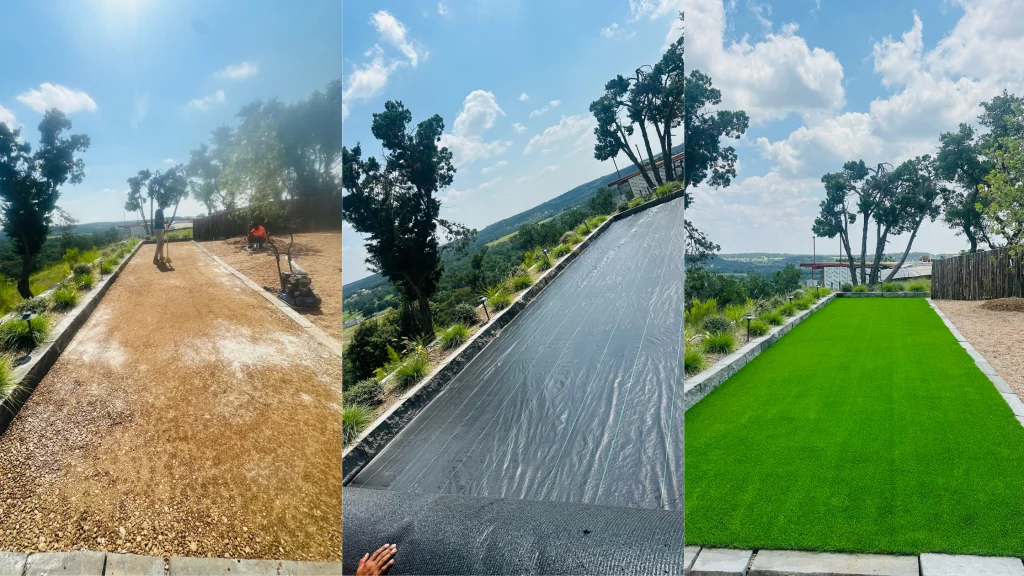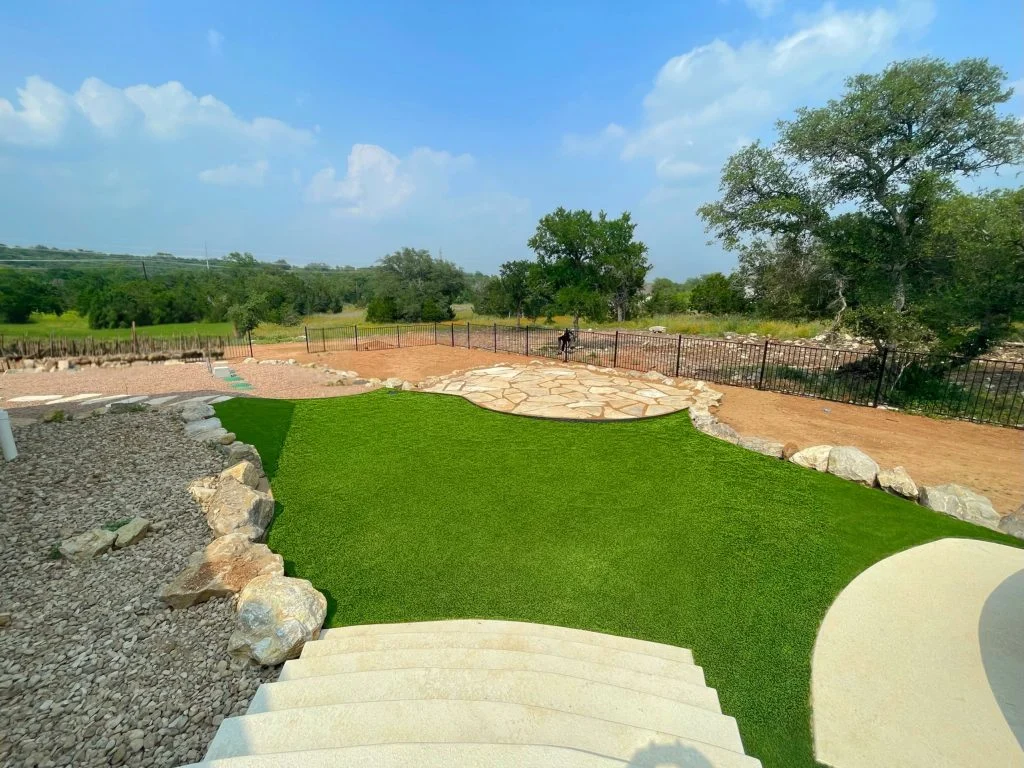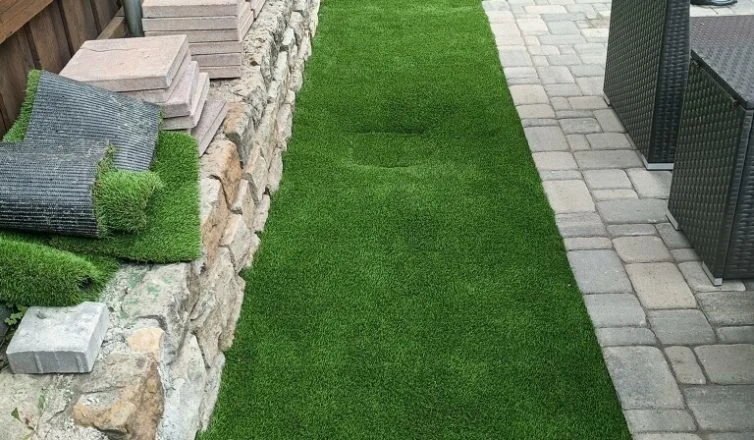When it comes to artificial turf, what you do before the turf is installed matters just as much as the turf itself. Proper prep for artificial turf installation is the difference between a yard that looks stunning for years versus one that buckles, puddles, or fades prematurely. Whether you’re a homeowner in the suburbs, a school administrator planning a playground renovation, or a property manager enhancing curb appeal, taking the time to prep for artificial turf is essential.
At Lone Star Turf, we guide clients through every stage of the installation process, making it smooth, worry-free, and built to last. Our commitment to precision prep and expert craftsmanship is backed by our industry-leading 16-year workmanship warranty and years of hands-on experience across residential and commercial projects.
Quick Summary: Your Turf Prep Checklist
For those who want the big picture at a glance, here’s a streamlined checklist of the major prep milestones before artificial turf installation begins:
- Planning & Site Assessment
- Measuring & Marking the Space
- Clearing and Cleaning the Area
- Grading and Base Preparation
- Drainage Planning
- Final Inspection and Pre-Install Readiness
Let’s break each of these down in more detail to help you understand what to expect, what’s your responsibility, and what Lone Star Turf expertly handles.
Why Proper Prep for Artificial Turf Matters
Installing artificial grass isn’t just about aesthetics; it’s about function, safety, longevity, and protecting your investment. If the base layer isn’t prepped correctly, the turf can shift, ripple, or trap water. Drainage issues can lead to mildew, odor, or even structural damage. Poor prep can void manufacturer warranties and result in costly repairs.
A professional turf installer like Lone Star Turf ensures all prep steps are completed with precision, from proper grading to smooth base layering. This isn’t the time to cut corners.

Step-by-Step Guide to Prep for Artificial Turf
1. Planning and Site Assessment
The process begins with a site evaluation. This is where your goals meet our expert recommendations. Lone Star Turf’s team will walk your space, take notes on usage (pets, kids, play, heavy foot traffic), identify any problem areas (like erosion or pooling), and assess the unique environmental factors of your region.
For clients in Texas and across the Southern U.S., this means factoring in intense heat, rainfall patterns, and soil types that vary from yard to yard. Your input is key here; this is when we listen to your goals and help match them with the best turf solution.
2. Measuring and Marking the Space
Next comes the sizing of the installation area. Lone Star Turf leads the way with precise measurements, but it’s helpful for homeowners or managers to point out underground sprinkler lines, decor items, or access points that shouldn’t be overlooked.
We flag obstacles, define clear perimeter lines, and plan around trees, flower beds, patios, and play structures. This ensures no surprises on install day.
3. Clearing and Cleaning the Area
Before turf can go down, what’s already there must come up. That includes existing grass, weeds, roots, rocks, debris, and any yard furniture or decor.
Lone Star Turf typically handles the removal of organic materials and heavy debris as part of our service, but we recommend customers move small items, pet waste, and personal structures ahead of time.
4. Grading and Base Preparation
Grading involves removing topsoil, shaping the land to promote drainage, and installing a crushed aggregate base that is compacted to perfection.
Inexperienced installers often overlook the precision this step requires for proper drainage, durability, and safety. Our crews use specialized equipment to achieve the correct slope and base depth every time. Many turf product manufacturers include guidelines for the necessary base prep and other installation steps that other turf installers ignore—but at Lone Star Turf, we carefully follow these instructions to give you the best possible results and protect your investment for the long haul.
5. Drainage Planning and Solutions
Especially in Southern states like Texas, Georgia, or Florida, where humidity and storms are common, planning for water movement is essential.
Lone Star Turf evaluates the natural drainage patterns of your property and can install solutions like French drains, channel drains, or added slope where needed. If you have pets, pooling problems, or shaded areas with poor evaporation, we factor that in too. We encourage customers to flag any drainage concerns early so we can discuss your options and decide whether to include them in your final quote.
6. Final Inspection and Pre-Install Readiness
Before turf ever touches the ground, double-check for proper base compaction, smooth surface prep, clear perimeters, and any remaining obstructions. This is the time to check in with your turf installer to align expectations, confirm layouts, and answer final questions before installation begins.
Special Considerations for Different Sites
Not all turf projects are the same. Here’s how our recommended synthetic turf preparation shifts based on use case:
Pet Zones/Dog Runs:
We may use antimicrobial infill and incorporate added drainage layers to prevent odor buildup and support quick clean-up.
Sloped Yards:
Extra grading, retaining solutions, or added base depth may be needed to prevent turf slippage or water pooling.
Sports Fields & Play Areas:
Shock-absorbing padding or underlayments may be added for safety, and the surface must be extremely level.
Commercial & School Installs:
Prep often includes permitting, ADA compliance, and working within tight scheduling windows for access.

Common Mistakes to Avoid When You Prep for Artificial Turf
Don’t fall into these common traps that can ruin your turf investment:
- Skipping or rushing base compaction
- Ignoring drainage needs
- Inaccurate measurements
- Leaving debris or roots under the turf
- Failing to communicate underground utilities or obstacles
- Not discussing concerns with your installer
Frequently Asked Questions (FAQ)
Can I prep for artificial turf myself?
Technically yes, but it’s a complex process that requires knowledge of soil, grading, and drainage. For lasting results, we recommend professional prep and installation.
How long does turf prep usually take?
Most residential projects are prepped in 1–2 days, depending on complexity, weather, and site conditions.
What happens if my yard isn’t perfectly flat?
That’s exactly why we grade and build a custom base. Slight slopes are expected and managed for optimal drainage.
Who removes my old grass and debris?
Lone Star Turf typically handles this as part of full-service installs. If you want to manage it yourself, just let us know, and we’ll coordinate accordingly.
What if I have pets or special landscape features?
Tell us early. We design solutions tailored to your needs, including pet-specific drainage, tree protection, poolside edging, and more.
Prep for Artificial Turf Installation With the Pros
When you prep for artificial turf the right way, you set the foundation for a yard that performs as beautifully as it looks. Whether your goals are low maintenance, water conservation, pet-friendliness, or curb appeal, it all starts with the groundwork.
At Lone Star Turf, we do more than install: we educate, anticipate, and execute with care. Let us help you get your project off on the right foot.
Contact us today to schedule a site assessment or start with a free instant estimate. Let’s make sure your artificial lawn is set up for lasting beauty and worry-free enjoyment.
Looking to learn more? Check out our Ultimate Guide to Artificial Turf!
